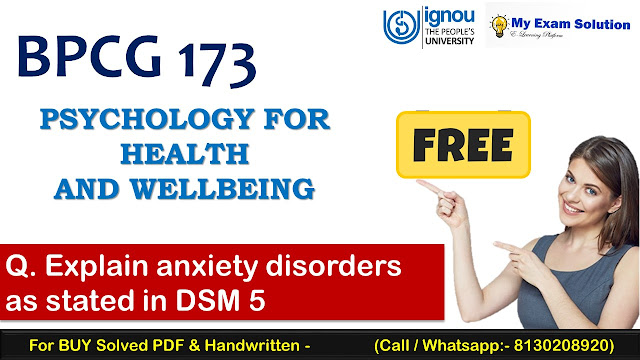Explain anxiety disorders as stated in DSM 5
Anxiety disorders refer to a group of mental health conditions characterized by excessive and persistent feelings of fear, worry, and unease. These disorders can significantly impact a person's daily life, causing distress and impairing their ability to function effectively.
Anxiety disorders are recognized as a distinct category in the
Diagnostic and Statistical Manual of Mental Disorders, Fifth Edition (DSM-5),
which provides a comprehensive classification and diagnostic criteria for
mental health disorders.
Explain anxiety disorders as stated in DSM 5-Anxiety is a normal and adaptive response to perceived threats or stressors. It helps prepare individuals to cope with challenges and dangers by triggering the "fight-or-flight" response, which activates various physiological and psychological mechanisms. However, in anxiety disorders, this response becomes dysregulated, leading to excessive and chronic anxiety that is disproportionate to the actual threat or situation.
Explain anxiety disorders as stated in DSM 5-The DSM-5 recognizes several primary anxiety disorders, including generalized anxiety disorder (GAD), panic disorder, specific phobia, social anxiety disorder (SAD), and separation anxiety disorder (SAD). Each disorder has unique characteristics, but they all share the common feature of excessive anxiety or fear.
1. Generalized Anxiety Disorder (GAD):
GAD is characterized by excessive and uncontrollable worry about various
aspects of life, such as work, relationships, and health. Individuals with GAD
often find it challenging to control their worries, and the anxiety is
typically present on most days for at least six months. GAD is associated with
symptoms such as restlessness, irritability, muscle tension, difficulty
concentrating, and sleep disturbances.
2. Panic Disorder: Panic disorder involves recurrent and unexpected panic attacks. Panic attacks are intense episodes of fear or discomfort that reach a peak within minutes, accompanied by physical symptoms such as palpitations, sweating, trembling, shortness of breath, and a sense of impending doom.
Also Read-
- Describe The Techniques Of Time Management
- Explain The Strength-Based Approach To Work
- Define Coping And Explain Its Goals
Explain anxiety disorders as stated in DSM 5-People with panic disorder often worry about
experiencing future panic attacks and may develop agoraphobia, a fear of
situations where escape might be challenging.
3. Specific Phobia: Specific phobia
refers to an intense and irrational fear of a specific object or situation. The
fear is excessive and disproportionate to the actual danger posed by the phobic
stimulus. Common specific phobias include fear of animals, heights, flying,
blood, and needles. When exposed to the feared stimulus, individuals may
experience immediate anxiety symptoms, such as a rapid heart rate, trembling,
and avoidance behaviors.
4. Social Anxiety Disorder (SAD): SAD, also known as social phobia, is characterized by an intense fear of social situations in which the individual may be scrutinized or judged by others. This fear is not merely shyness but reaches a level where it significantly interferes with daily life.
Explain anxiety disorders as stated in DSM 5-People with SAD often avoid social interactions,
experience extreme self-consciousness, and may fear embarrassment or
humiliation. Physical symptoms, such as blushing, sweating, and trembling,
commonly accompany social anxiety.
5. Separation Anxiety Disorder (SAD):
SAD primarily affects children and is characterized by excessive fear or
anxiety concerning separation from attachment figures, such as parents or
caregivers. Children with SAD may have difficulty attending school, staying
alone, or sleeping without the presence of their attachment figures. Physical
symptoms, such as headaches and stomachaches, are also common. While SAD is
most commonly observed in childhood, it can persist into adulthood in some
cases.
6. Other Specified Anxiety Disorders:
The DSM-5 also recognizes other specified anxiety disorders, which include
conditions that share anxiety-related symptoms but do not meet the full
criteria for any specific disorder. For example, individuals may experience
significant anxiety symptoms in response to a medical condition, such as
anxiety due to a chronic illness or anxiety induced by substance use or
medication.
Overall, anxiety disorders described in DSM-5 involve excessive and persistent fear or worry, leading to significant distress and impairment. It is important to note that a proper diagnosis can only be made by a qualified mental health professional based on a comprehensive evaluation of symptoms and impairment.
Explain anxiety disorders-Treatment options for
anxiety disorders include psychotherapy, medication, and various self-help
strategies, all of which aim to reduce anxiety symptoms and enhance overall well-being.







0 comments:
Note: Only a member of this blog may post a comment.